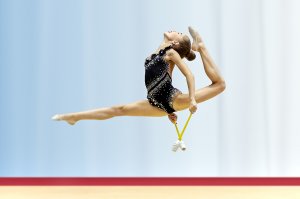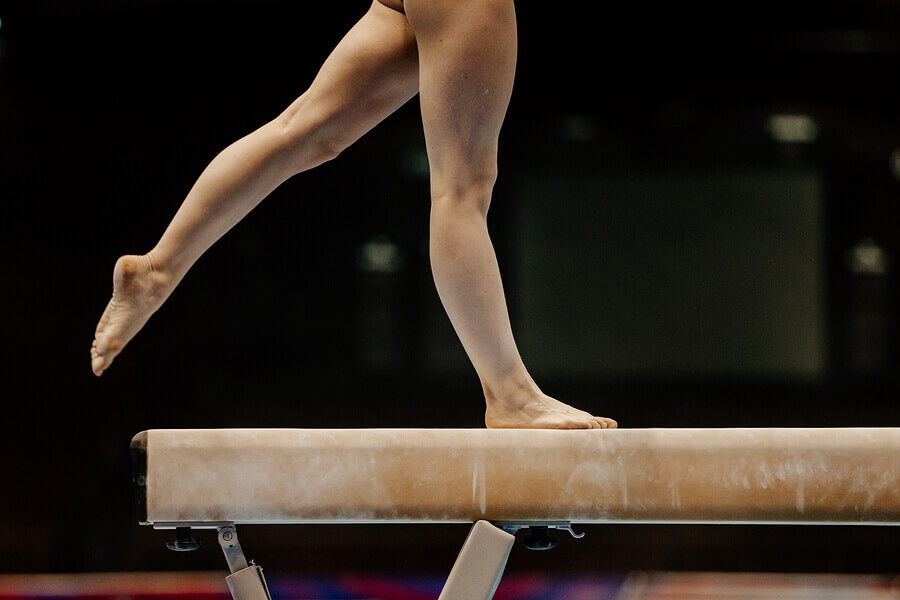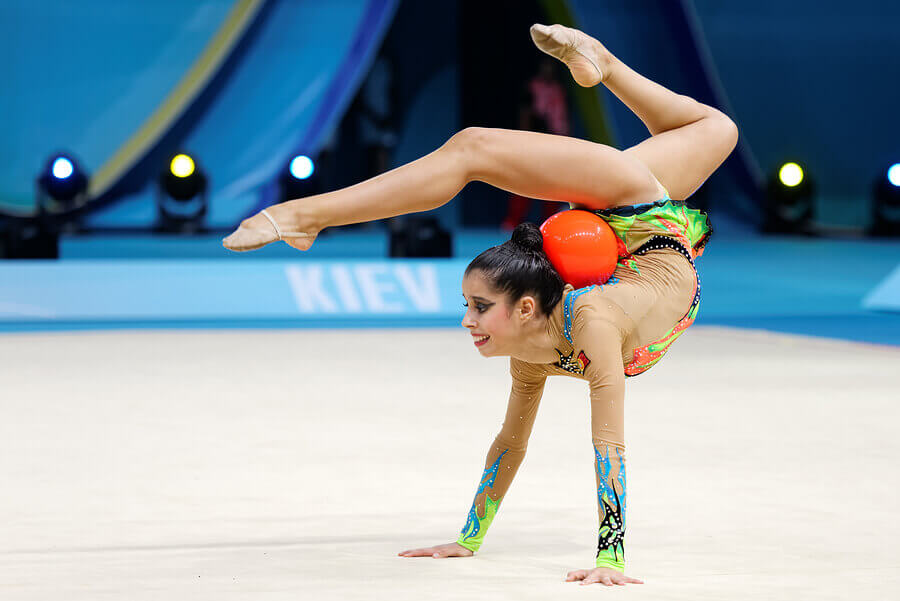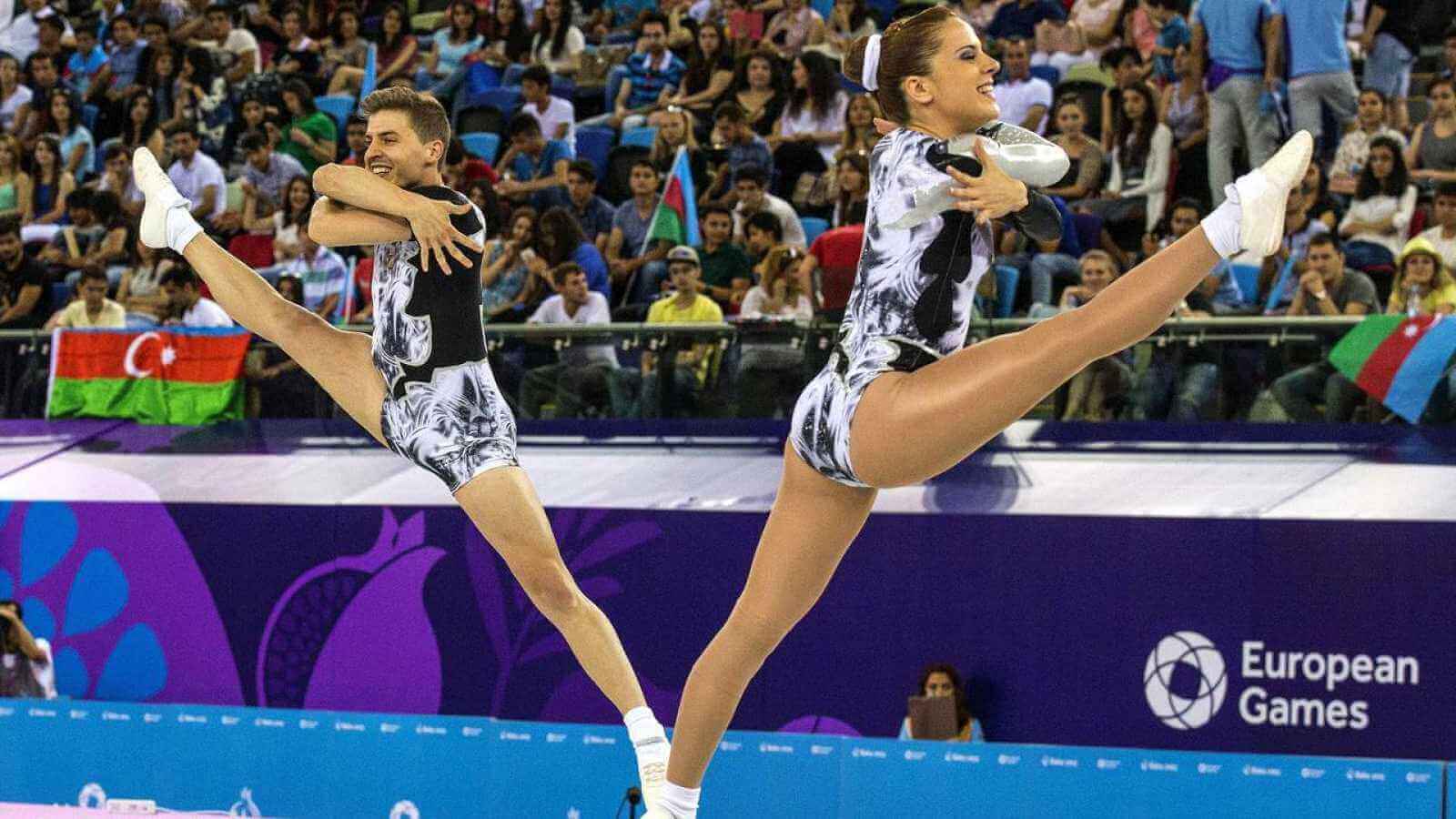5 Gymnastic Disciplines

Only second to track and field, gymnastics is the largest family of different disciplines. Read about these different gymnastic disciplines in our post today.
Gymnastics: a sport with many disciplines
Gymnastics goes back further than you might think. In Ancient Greece, athletes were already doing the same exercises and events that we know today. “Modern gymnastics”, as we know it today, falls under the regulation of the International Gymnastics Federation and encompasses the following disciplines:
1. Artistic gymnastics: one of the many gymnastic disciplines
In addition to being one of the most popular Olympic events, artistic gymnastics is one of the best-known disciplines of the group. Artistic gymnastics first appeared in the Olympic program in the 1896 Athens Games for men. The women’s events followed later in 1928.
The artistic presentations are normally individual and last between 30 to 90 minutes on different surfaces. Women gymnasts compete on uneven bars (bars at different heights), balance beam (with acrobatic movements), floor (choreography) and vault.

Meanwhile, the men’s events are rings (gymnasts don’t touch the floor during their entire performance), horizontal bar (2.80 meters high), pommel horse, parallel bars, vault, and floor.
2. Rhythmic gymnastics
Another popular discipline and Olympic event are rhythmic gymnastics. This sport isn’t just about gymnastics, but also combines elements of dance and ballet. While the discipline has been around since ancient history, it’s a relatively new event in the Olympics. In the Olympics, this discipline first appeared as an individual event in 1984, then as a group event as well in 1996.
The gymnasts must perform their routine in sync with their music. Furthermore, their routine must include leaps, balances, pivots, flexibility movements and rolls.
During official performances, they use certain elements: rope, hoop, ball, sticks, and ribbon. The judges evaluate the performances based on the difficulty of the routine and execution. Currently, the strongest rhythmic gymnastic performers come from Russia, ex-Soviet Union countries, Bulgaria, Spain, and Italy.

3. Another of the many gymnastic disciplines: trampolining
Just as its name suggests, trampolining events take place on a trampoline. Designed in the United States in 1934, it’s a relatively new discipline. The first trampolining world championship took place in 1964 and the sport became an official Olympic event in 2000.
There are three main competitive events in trampolining: tumbling, double mini-tramp and individual trampoline. The first consists of performing on a 25-meter long trampoline; meanwhile double mini-tramp uses a 3-meter long trampoline; lastly, individual trampoline encompasses the obligatory and freestyle events of 10 elements.
We can also add synchronized trampolining on to this list. In a synchronized trampoline, a gymnast duo performs the same routine alongside each other on parallel trampolines.
4. Aerobic gymnastics:
Aerobic gymnastics, or sport aerobics, performances last for one minute and is packed with high-intensity movements and diverse elements. Gymnasts must show their flexibility skills, strength, and continuous movement in their 60-second routine.
Aerobic gymnastics is made up of different categories: individual, same-sex pairs, mixed pairs, trios, groups (5 members), aero dance (8 members) and aero step (8 members).

5. Acrobatic gymnastics: the last on our list of gymnastic disciplines
Acrobatic gymnastics is the last discipline on our list. It’s also known as acro sport and officially joined the International Gymnastics Federation in 1999. The events contain different acrobatic and gymnastic elements such as leaps, pivots, flexibility skills and balance.
Each exercise lasts around two and a half minutes. Furthermore, the gymnasts perform on a 12 x 12-meter mat. There are four categories: pair (mixed or same-sex), trios (women, men or mixed), quartet (women, men or mixed) and groups (mixed six members).
In acrobatic gymnastics, the gymnasts adopt different positions: base (bottom of the pyramid), top (lifts or jumps), support (helps teammates). Acrobatic events consist of assembling a structure, maintaining a pyramid and disassembly, which has to be in reverse assembling order.
Lastly, we also want to mention Gymnastics for All. Gymnastics for All isn’t a competitive form of gymnastics but still forms part of the International Gymnastics Federation. It allows gymnasts of all ages to participate. The synchronized choreography is divided into three categories, ranging in difficulty of the movements.
Only second to track and field, gymnastics is the largest family of different disciplines. Read about these different gymnastic disciplines in our post today.
Gymnastics: a sport with many disciplines
Gymnastics goes back further than you might think. In Ancient Greece, athletes were already doing the same exercises and events that we know today. “Modern gymnastics”, as we know it today, falls under the regulation of the International Gymnastics Federation and encompasses the following disciplines:
1. Artistic gymnastics: one of the many gymnastic disciplines
In addition to being one of the most popular Olympic events, artistic gymnastics is one of the best-known disciplines of the group. Artistic gymnastics first appeared in the Olympic program in the 1896 Athens Games for men. The women’s events followed later in 1928.
The artistic presentations are normally individual and last between 30 to 90 minutes on different surfaces. Women gymnasts compete on uneven bars (bars at different heights), balance beam (with acrobatic movements), floor (choreography) and vault.

Meanwhile, the men’s events are rings (gymnasts don’t touch the floor during their entire performance), horizontal bar (2.80 meters high), pommel horse, parallel bars, vault, and floor.
2. Rhythmic gymnastics
Another popular discipline and Olympic event are rhythmic gymnastics. This sport isn’t just about gymnastics, but also combines elements of dance and ballet. While the discipline has been around since ancient history, it’s a relatively new event in the Olympics. In the Olympics, this discipline first appeared as an individual event in 1984, then as a group event as well in 1996.
The gymnasts must perform their routine in sync with their music. Furthermore, their routine must include leaps, balances, pivots, flexibility movements and rolls.
During official performances, they use certain elements: rope, hoop, ball, sticks, and ribbon. The judges evaluate the performances based on the difficulty of the routine and execution. Currently, the strongest rhythmic gymnastic performers come from Russia, ex-Soviet Union countries, Bulgaria, Spain, and Italy.

3. Another of the many gymnastic disciplines: trampolining
Just as its name suggests, trampolining events take place on a trampoline. Designed in the United States in 1934, it’s a relatively new discipline. The first trampolining world championship took place in 1964 and the sport became an official Olympic event in 2000.
There are three main competitive events in trampolining: tumbling, double mini-tramp and individual trampoline. The first consists of performing on a 25-meter long trampoline; meanwhile double mini-tramp uses a 3-meter long trampoline; lastly, individual trampoline encompasses the obligatory and freestyle events of 10 elements.
We can also add synchronized trampolining on to this list. In a synchronized trampoline, a gymnast duo performs the same routine alongside each other on parallel trampolines.
4. Aerobic gymnastics:
Aerobic gymnastics, or sport aerobics, performances last for one minute and is packed with high-intensity movements and diverse elements. Gymnasts must show their flexibility skills, strength, and continuous movement in their 60-second routine.
Aerobic gymnastics is made up of different categories: individual, same-sex pairs, mixed pairs, trios, groups (5 members), aero dance (8 members) and aero step (8 members).

5. Acrobatic gymnastics: the last on our list of gymnastic disciplines
Acrobatic gymnastics is the last discipline on our list. It’s also known as acro sport and officially joined the International Gymnastics Federation in 1999. The events contain different acrobatic and gymnastic elements such as leaps, pivots, flexibility skills and balance.
Each exercise lasts around two and a half minutes. Furthermore, the gymnasts perform on a 12 x 12-meter mat. There are four categories: pair (mixed or same-sex), trios (women, men or mixed), quartet (women, men or mixed) and groups (mixed six members).
In acrobatic gymnastics, the gymnasts adopt different positions: base (bottom of the pyramid), top (lifts or jumps), support (helps teammates). Acrobatic events consist of assembling a structure, maintaining a pyramid and disassembly, which has to be in reverse assembling order.
Lastly, we also want to mention Gymnastics for All. Gymnastics for All isn’t a competitive form of gymnastics but still forms part of the International Gymnastics Federation. It allows gymnasts of all ages to participate. The synchronized choreography is divided into three categories, ranging in difficulty of the movements.
All cited sources were thoroughly reviewed by our team to ensure their quality, reliability, currency, and validity. The bibliography of this article was considered reliable and of academic or scientific accuracy.
- Vernetta Santana, M., & Delgado Noguera, M. (1996). Aprendizaje en gimnasia artística: Un estudio experimental con niños que analiza ciertas variables del proceso. European Journal of Human Movement.
This text is provided for informational purposes only and does not replace consultation with a professional. If in doubt, consult your specialist.








